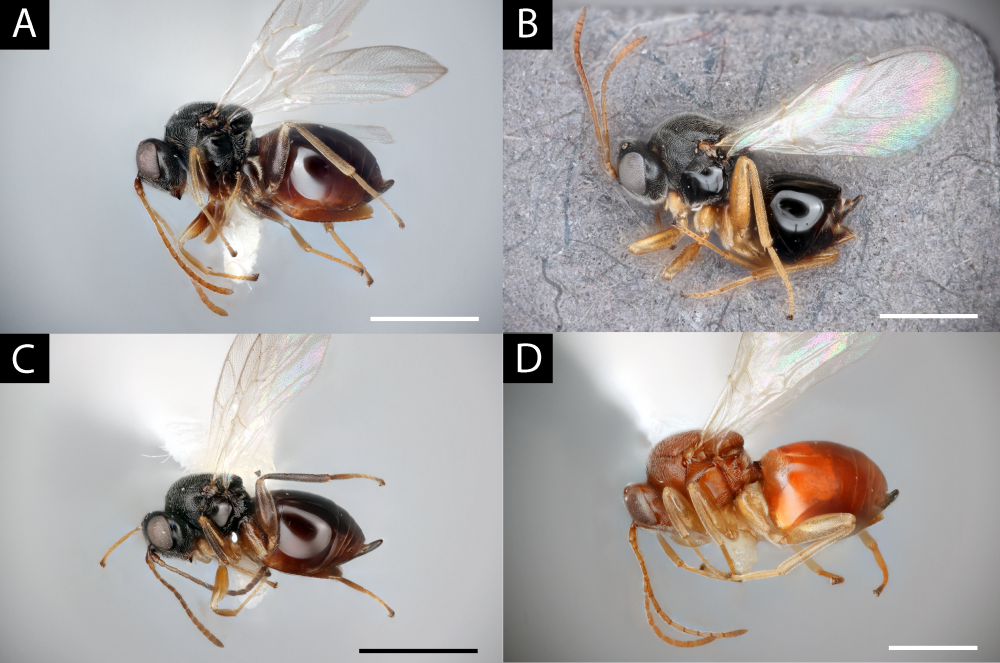A taxonomist’s work is never done, as the title of a recent study that identified 22 new species of tiny parasitic wasps would suggest. “One must imagine Sisyphus happy: Integrative taxonomic characterization of 22 new Ceroptres species” dives into the curious world of gall-raiding wasps, discovering a host of new-to-science species that have been given some truly incredible names. Sisyphus? I think Jabba The Hut would be happy.
For the systematist authors of the paper, the task of identifying new species is as invigorating as it is endless – a viewpoint that must come in handy while studying the Cynipoidea wasps. These tiny insects keep enrolling more species into the fold, and they just got a massive injection of 22 more mini beasties.
This is in part due to them being historically poorly studied, but this new study took a closer look at a wasp group to see who might be hiding in the crowd. They’re known as inquiline gall wasps because they lay eggs inside plant galls, giant lumps that have a curious history all of their own.
If you’ve ever seen a giant lump on a tree, you might have thought the plant was sick, but chances are it could’ve been a wasp nest. Wasps appear to inject something into leaves that causes them to grow a gall that protects their eggs, keeping them safe from predators and the weather. Some wasps make their own galls, while other wasps raid existing ones.
Oak leaves are a common target, and this latest study primarily focused on Ceroptres specimens that were reared from galls on oaks that had been harvested for another research project. This was done by placing field-collected galls in incubators and catching whatever came out, and scientists aren’t the only living organisms stealing wasp galls.
A: Ceroptres daleki, B: Ceroptres jabbai, C: Ceroptres jarethi, and D: Ceroptres promethei.
Image courtesy of Louis Nastasi
Using a combination of imaging and phylogenetic analyses conducted on both their study wasps and data from past research, they were able to identify species that hadn’t before been recognized.
“We discovered and named 22 new species of inquiline gall wasps, which overtake galls on oak trees produced by other species of wasps,” study author and doctoral candidate at Pennsylvania State University Louis Nastasi told IFLScience. “We named our new species after a fun selection of pop culture icons (Jabba the Hutt!), folk heroes, and figures from folklore and mythology.”
Among the IFLScience favorites are Ceroptres jarethi, named for Jareth the Goblin King, (David Bowie’s character in Jim Henson’s 1986 film Labyrinth). C. promethei, named for the titan Prometheus from Greek mythology, and C. daleki, named for the Daleks from the Doctor Who franchise. And – of course – C. jabbai, the Star Wars star who needs no introduction.
The new recruits also include some of the first to ever be officially associated with midges, something we’ve long suspected but not yet had the hard evidence to prove. It’s a fascinating addition to this curious cast of wasps, but just like Sisyphus and his boulder, these systematists’ work is far from over.
“Overall, we find that species of Ceroptres are host specialists associated with a single host gall species or several galls that are phylogenetically or ecologically related. We suggest that there are many North American species of Ceroptres, possibly hundreds, still awaiting collection and characterization,” the study authors write.
The study is published in ZooTaxa.
Source Link: Jabba The Hutt Wasp Among 22 New Species Of Parasitic Gall Raiders
